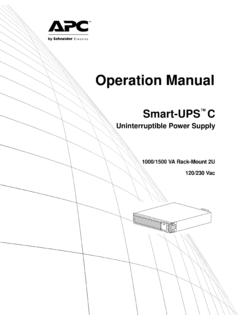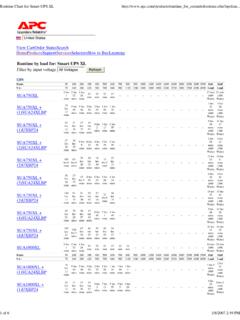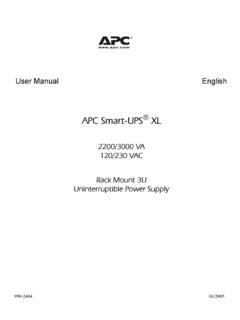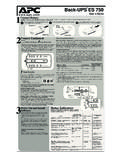Transcription of APC SmartAPC Smart---UPSUPS - APC UPS, APC …
1 990-1704 01/2004 User Manual EnglishAPC SmartAPC SmartAPC SmartAPC smart ----UPSUPSUPSUPS 1500/3000 VA 120/230 Vac1500/3000 VA 120/230 Vac1500/3000 VA 120/230 Vac1500/3000 VA 120/230 Vac ModularModularModularModular uninterruptible power SupplyUninterruptible power SupplyUninterruptible power SupplyUninterruptible power supply 1 Introduction This APC smart -UPS is a modular uninterruptible power supply (UPS) for high availability applications such as data centers and mission critical processes, designed to prevent blackouts, brownouts, sags, and surges from reaching your equipment. The UPS filters small utility line fluctua-tions and isolates your equipment from large disturbances by internally disconnecting from the utility line. The UPS provides continuous power from its internal battery until the utility line returns to safe levels or the battery is fully discharged.
2 1: INSTALLATION The User Manual and Safety Guide are accessible on the supplied User Manuals CD and on the APC web site, Unpack Attention: Read the safety instruction sheet before installation. Inspect the UPS upon receipt. Notify the carrier and dealer if there is damage. The packaging is recyclable; save it for reuse or dispose of it properly. Check the package contents: UPS Bezel Tower conversion top panels and mounting stabilizers Rail kit UPS literature kit containing: Product documentation, safety, and warranty information smart -UPS User Manuals CD PowerChute CD Network Management Card CD Mounting hardware Serial and USB communication cables 230 V models only: Two input power cords Four output jumper cords Position the UPS in the Specified Environment 0-95% 0-40 C 2 Mount the UPS in the Rack and Connect the Battery Attention: Install the rails following the instructions in the rail kit.
3 Rear 3 Tower Configuration Press and hold the black switch (see location designation on UPS) to the right while removing the power processing module. Note: Place the UPS in the final operating loca-tion prior to module reinstallation. Snap the display bezel out the rear to begin rotation. Rear 4 2: START UP Connect Equipment to the UPS Rear Panels 1500 VA, 120 V: 1500 VA, 230 V: 3000 VA, 120 V: 3000 VA, 230 V: Note: The outlet groups can be controlled through the network software. See Network Management Card documentation. A laser printer draws significantly more power than other types of equipment and may overload the UPS. Connect the UPS to the Network (if Applicable) Network Connectors Serial Port USB Port Ethernet Port Note: Use only the supplied cable to connect to the Serial Port. A standard serial interface cable is in-compatible with the UPS.
4 Serial and USB ports cannot be used simultaneously. If an optional smart -Slot accessory is to be used, remove the preinstalled network management card and install it now. Start the UPS Attention: Upon utility power connection, the UPS will automatically turn on. 1. Plug the UPS into a two-pole, three-wire, grounded receptacle only. Input Plugs: 1500 VA models: 120 V = NEMA 5-15P; 230 V = Use country specific 10 A with C14 input cords (not supplied). 3000 VA models: 120 V = NEMA L5-30P; 230 V = Use the supplied cords or the country spe-cific equivalent. 5 The battery will charge to full capacity during the first few hours of normal operation. Do not expect full on battery capability during this initial charge period. 2. After the UPS has ended the immediate self-test with online LED illumination, check the front display for any fault indicators (see Troubleshooting).
5 3. 120 V models: Check the site wiring fault LED located on the rear panel. It will be illuminated if the UPS is plugged into an improperly wired utility power outlet (see Troubleshooting). 4. Turn on all connected equipment. To use the UPS as a master on/off switch, be sure all con-nected equipment is on. Equipment is now powered and protected. Basic operation, user configuration, and software utiliza-tion can now be performed as required. Battery Operation The UPS switches to battery operation automatically if the utility power fails. While running on bat-tery, an alarm beeps four times every 30 seconds. Press the button to silence this alarm. If the utility power does not return, the UPS continues to supply power to the connected equipment until the battery is fully discharged. Refer to for battery runtime charts. When the UPS reaches the low battery shutdown warning (two minute default), the alarm will beep continuously until total shutdown.
6 Connected equipment should be shut down during this time, unless being controlled by network monitoring software. 6 3: BASIC OPERATION Front Display Panel INDICATOR DESCRIPTION Online The UPS is supplying utility power to the connected equipment. AVR The UPS is compensating for either a high or low utility voltage. On Battery The UPS is supplying battery power to the connected equipment. Overload The connected loads are drawing more than the UPS power rating. Bypass The connected loads are being powered directly by the utility power connection and not through the power processing module. This is a fault condition, which may be caused by an overload or a failure within the module (see Troubleshoot-ing). Replace Battery/ Battery Disconnected The battery is disconnected or must be replaced. FEATURE FUNCTION power Off Press this button to turn off the UPS.
7 7 FEATURE FUNCTION Self-Test Automatic: The UPS performs a self-test automatically when turned on, and every two weeks thereafter (by default). During the self-test, the UPS briefly operates the connected equipment on battery. Manual: Press and hold the button for a few seconds to initiate the self-test. Cold Start supply battery power to the UPS and connected equipment in the absence of utility voltage (see Troubleshooting). Press the button for one second and release. The UPS will beep briefly and go quiet. Press and hold the button again, but for approximately three seconds. The unit will emit a sustained beep. Re-lease the button during this beep. Diagnostic Utility Voltage The UPS has a diagnostic feature that displays the utility voltage. The UPS starts a self-test as part of this procedure. The self-test does not affect the voltage display.
8 Press and hold the button to view the utility voltage bar graph display. After a few seconds, this five-LED battery charge display on the right of the front panel will show the utility input voltage. Refer to the figure at left for the voltage reading (values are not listed on the UPS). The display indicates the voltage is between the displayed value on the list and the next higher value (see Troubleshooting). 8 4: USER CONFIGURABLE ITEMS NOTE: SETTINGS ARE MADE THROUGH THE SUPPLIED POWERCHUTE SOFTWARE OR THE NETWORK INTERFACE CONNECTION. REFER TO THE SOFTWARE HELP GUIDES FOR DETAILS. FUNCTION FACTORY DEFAULT USER SELECTABLE CHOICES DESCRIPTION Automatic Self-Test Every 14 days (336 hours) Every 14 days (336 hours), Every 7 days (168 hours), On Startup Only, No Self-Test This function sets the interval at which the UPS will execute a self-test.
9 UPS ID UPS_IDEN Up to eight characters Use this field to uniquely identify the UPS, ( server name or location) for network management purposes. Date of Last Battery Replacement Manufacture Date mm/dd/yy Reset this date when you replace the inter-nal battery module. Minimum Capacity Before Return from Shutdown 0 percent 0, 15, 30, 45, 60, 75, 90 percent The UPS will charge its batteries to the specified percentage before powering up connected equipment, following a low-battery shutdown. Voltage Sensitivity High High, Medium, Low The UPS detects and reacts to line voltage distortions by transferring to battery power to protect the connected equipment. When power quality is poor, the UPS may fre-quently transfer to battery power . If the connected equipment can operate normally under such line voltage conditions, reduce the sensitivity setting to conserve battery s capacity and service life.
10 Alarm Control Enable Enable, Mute, Disable User can mute an ongoing alarm or disable all existing alarms permanently. Shutdown Delay 90 seconds 90, 180, 270, 360, 450, 540, 630, 0 seconds The interval is set between the times when the UPS receives a shutdown command and when it shuts off power to the outlets. Low Battery Warning 2 minutes 2, 5, 8, 11, 14, 17, 20, 23 minutes PowerChute software provides automatic, unattended shutdown when the remaining battery runtime matches this setting while on battery. Change the low battery warning interval default setting to the time that the operating system or system software requires to safely shut down. Synchronized Turn-on Delay 0 seconds 0, 60, 120, 180, 240, 300, 360, 420 seconds The UPS will wait the specified time after the return of utility power before turn-on (to avoid branch circuit overload). 9 NOTE: SETTINGS ARE MADE THROUGH THE SUPPLIED POWERCHUTE SOFTWARE OR THE NETWORK INTERFACE CONNECTION.












